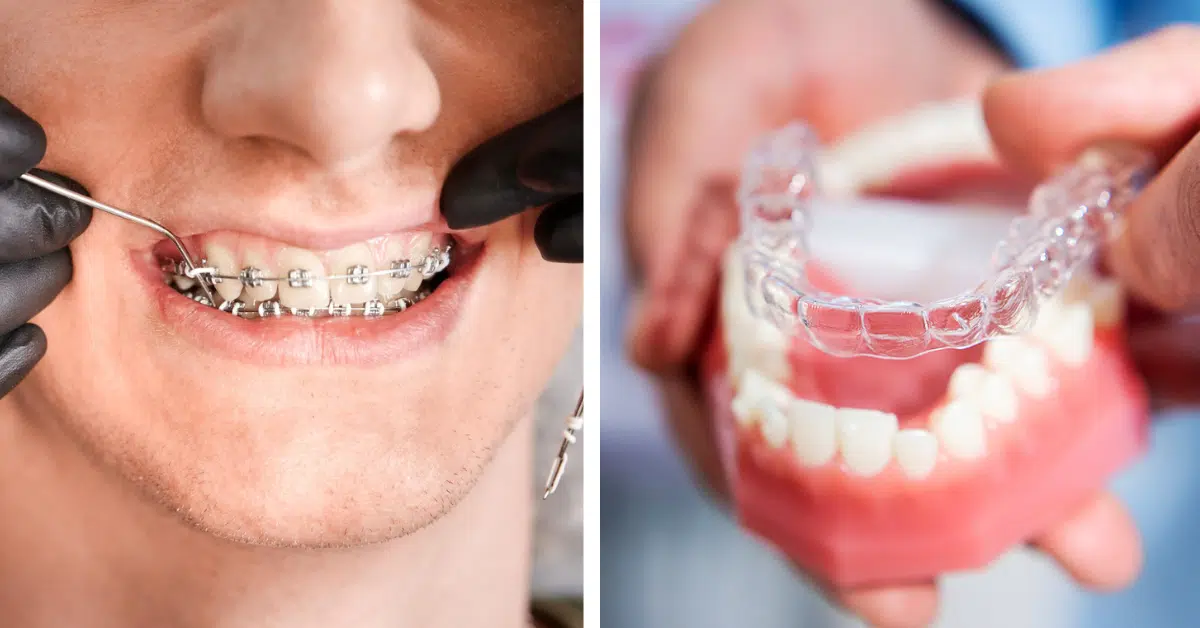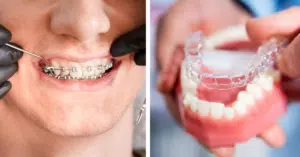Perfecting Your Smile: Navigating the Invisalign vs. Braces Debate

A bright, confident smile can make a world of difference in our lives. It’s more than just a facial feature; it’s a powerful tool that boosts self-esteem and leaves a lasting impression. If you’re reading this, chances are you’re considering orthodontic treatment to perfect your smile. While you’re a step ahead on the path to a more aligned smile, the choice still stands: Invisalign vs. braces—which is better?
Understanding Invisalign and Braces
Orthodontic treatment has come a long way, offering innovative solutions to help you achieve that perfect smile. Many choose between Invisalign vs. braces since these are two of the most common orthodontic treatments used to correct various dental issues.
Invisalign

- Invisalign utilizes a series of clear, removable aligners custom-made to fit your teeth.
- These aligners are virtually invisible when worn and are designed to gradually move your teeth into their desired positions.
- The treatment involves a series of aligner trays, each worn for a specified period, with occasional check-ups to monitor progress and provide new aligners.
Traditional Braces
- Traditional braces consist of wires connecting metal or ceramic brackets to your teeth.
- Braces work by applying constant pressure to guide your teeth into proper alignment.
- Your orthodontist makes adjustments on a regular basis to monitor progress and address any necessary modifications.
Historical Overview
Both Invisalign vs. braces have unique histories and have evolved over time to offer improved results and comfort.
Invisalign:
- Invisalign, introduced in the late 1990s, revolutionized orthodontics by offering a discreet and convenient alternative to traditional braces.
- Technological advancements have enhanced the precision of Invisalign treatment, making it suitable for a wide range of orthodontic issues.
Traditional Braces:
- Traditional braces have been in use for centuries, with modern braces incorporating various materials and design improvements to enhance comfort and effectiveness.
- Today, braces are more comfortable and aesthetically pleasing than ever before, offering a comprehensive solution for correcting dental issues.
Invisalign vs. Braces: Comparing Effectiveness
When it comes to orthodontic treatment, comparing the effectiveness of Invisalign vs. braces in addressing various dental issues is a crucial consideration.
Effectiveness of Invisalign
Invisalign is renowned for its versatility and ability to treat a wide range of orthodontic issues, including:
- Misalignment: Invisalign can effectively correct misaligned teeth, improving both their appearance and functionality.
- Overcrowding: If your teeth are crowded or overlapping, Invisalign aligners can gradually create space, aligning your teeth properly.
- Overbite and Underbite: Invisalign can address overbites and underbites by gradually moving the upper and lower teeth into their ideal positions.
- Crossbite: Crossbites, where teeth are misaligned when the jaws come together, can be corrected with Invisalign.
- Gap Closure: Invisalign can be an excellent choice for closing small to moderate gaps between teeth.
- Rotations and Twisting: Invisalign aligners are designed to rotate teeth to their desired orientation, correcting twisted or rotated teeth.
- Open Bite: Invisalign can help in cases of open bites where the upper and lower teeth do not meet properly.
Effectiveness of Traditional Braces
Traditional braces are highly effective in treating a wide range of orthodontic issues as well.
- Severe Misalignment: For more severe misalignment cases, traditional braces provide precise control over tooth movement.
- Complex Cases: Complex dental issues, such as severe overbites, underbites, or crossbites, can be effectively addressed with braces.
- Crowding: Braces can create ample space for crowded teeth, allowing them to align properly.
- Gap Closure: Braces are particularly effective for closing larger gaps and spaces between teeth.
- Correction of Vertical Position: Braces can address vertical positioning issues, ensuring teeth are in their ideal places.
- Correction of Rotations: Braces can correct significant rotations or twisting of teeth.
- Jaw Alignment: In cases where jaw alignment is a concern, traditional braces can help align the jaw for proper bite function.
Invisalign vs. Braces: Comfort and Convenience
Orthodontic treatment not only aims to improve your smile but also considers your comfort and convenience throughout the process. But in the Invisalign vs. braces, which is more comfortable and convenient?
Comfort with Invisalign
- Smooth and Removable: Invisalign aligners are made of smooth, comfortable plastic, minimizing the irritation and soreness often associated with braces’ metal components.
- No Dietary Restrictions: Since Invisalign aligners are removable, you can enjoy all your favorite foods without worrying about damaging brackets or wires. Simply take them out while eating and brush your teeth before putting them back in.
- Easy Maintenance: Cleaning Invisalign aligners is straightforward. Rinse them with warm water and use a soft toothbrush to maintain their clarity and hygiene.
- Fewer Appointments: Invisalign typically requires fewer in-person appointments for adjustments compared to traditional braces, making it a more convenient option for some individuals.
Comfort with Traditional Braces
- Sturdy and Effective: Traditional braces are known for their reliability in treating complex orthodontic issues effectively.
- No Compliance Required: With braces, there’s no need to remember to wear aligners; they work continuously, providing consistent pressure for tooth movement.
- No Risk of Misplacement: Since braces are fixed on your teeth, there’s no risk of losing or misplacing them, ensuring constant progress.
- Adjustments as Needed: Regular appointments with your orthodontist ensure adjustments are made to keep the treatment on track.
Daily Life Considerations
- Speech: Initially, some individuals may experience difficulty speaking with braces due to the presence of brackets and wires. Invisalign’s smooth aligners typically do not interfere with speech.
- Aesthetics: Invisalign aligners are nearly invisible when worn, offering a discreet option for those concerned about the appearance of traditional braces.
- Sports and Activities: Invisalign aligners can be temporarily removed for sports or activities that require a mouthguard. Braces may require specialized mouthguards for protection.
- Special Occasions: Invisalign offers flexibility for special occasions where you may prefer to go without aligners temporarily.
Invisalign vs. Braces: Aesthetics and Visibility
The aesthetics of orthodontic treatment can be a significant consideration for many individuals, especially those concerned about the appearance of their smile during the treatment process.
Aesthetics with Invisalign
- Virtually Invisible: Invisalign aligners are made from clear plastic and are nearly invisible when worn. This feature makes them a popular choice for individuals who prefer a discreet treatment option.
- Natural Smile: Invisalign allows your natural smile to shine through, without the presence of brackets and wires that are characteristic of traditional braces.
- Minimal Impact on Appearance: Invisalign aligners have a minimal impact on your facial appearance, allowing you to feel confident in social and professional settings.
- Photography-Friendly: Invisalign is a popular choice for those who want to avoid braces’ noticeable appearance in photographs and selfies.
Aesthetics with Traditional Braces
- Variety of Options: Traditional braces offer various bracket and band color options, allowing for some personalization and style choices.
- Colored Bands: Many patients, especially children and teenagers, enjoy the opportunity to choose colored bands for a fun and unique look.
- Metallic or Ceramic: Traditional braces come in both metallic and ceramic varieties, with ceramic braces blending in better with natural tooth color.
- Customizable Appearance: Some individuals embrace the opportunity to customize the appearance of their braces to make a fashion statement.
Visibility Considerations
- Invisalign: Invisalign aligners are virtually invisible, making them an excellent choice for individuals who want a discreet treatment option. Most people won’t even notice you’re wearing them.
- Traditional Braces: While modern braces are more visually appealing than in the past, they are still noticeable due to the presence of brackets and wires. Some individuals embrace the traditional brace look, while others may feel self-conscious about their visibility.
Treatment Duration and Maintenance
Understanding how long your orthodontic treatment will take and what maintenance is required is crucial in choosing between Invisalign vs. braces.
Treatment Duration with Invisalign
- Variable Duration: The duration of Invisalign treatment can vary significantly based on your specific orthodontic issues. For some individuals, it may take as little as a few months, while others may require treatment for a year or more.
- Progress Monitoring: Invisalign treatment involves wearing a series of aligner trays, with each tray worn for about one to two weeks. Progress is monitored through periodic check-ups with your orthodontist.
- Compliance is Key: The effectiveness of Invisalign aligners largely depends on your commitment to wearing them as prescribed (typically 20–22 hours a day). Compliance is essential for achieving the desired results within the estimated timeframe.
Maintenance with Invisalign
- Oral Hygiene: Maintaining good oral hygiene is crucial with Invisalign. You should remove aligners before eating or drinking anything other than water and brush your teeth before putting them back in.
- Cleaning Aligners: Clean your Invisalign aligners regularly by rinsing them with warm water and using a soft toothbrush to remove any buildup or debris.
- Regular Check-ups: You’ll need to attend regular check-up appointments with your orthodontist to ensure your treatment is progressing as planned and to receive new aligner trays.
Treatment Duration with Traditional Braces
- Fixed Treatment Timeline: Traditional braces typically have a fixed treatment duration, which can range from one to three years, depending on the complexity of your case.
- Adjustments: Regular appointments with your orthodontist are necessary for adjustments, wire changes, and ensuring the treatment stays on track.
Maintenance with Traditional Braces
- Oral Hygiene: Maintaining oral hygiene with braces requires extra effort. Special brushes and flossing tools may be recommended to clean around brackets and wires effectively.
- Dietary Considerations: Certain foods should be avoided to prevent damage to braces, such as hard or sticky foods that can break brackets or wires.
- Adjustments: Regular orthodontic appointments are crucial for adjustments, wire changes, and addressing any issues that may arise during treatment.
Discover Your Perfect Smile with Trusted Orthodontic Care
With a rich history of providing outstanding orthodontic care to patients of all ages in Tacoma, Lakewood, Fircrest, University Place, Puyallup, Joint Base Lewis-McChord, and beyond since 1994, Pacific Northwest Orthodontics takes pride in our commitment to creating beautiful, confident smiles.
Whether you’re considering traditional braces, Invisalign clear aligners, ceramic braces, or any of our other state-of-the-art services, our team is dedicated to delivering personalized, high-quality care in a family-friendly environment. Join our orthodontic family and experience the difference at Pacific Northwest Orthodontics!
Contact us today to schedule your consultation, and let’s start your journey toward a smile you’ll be glad to show off!




